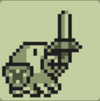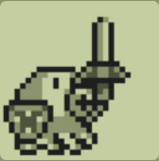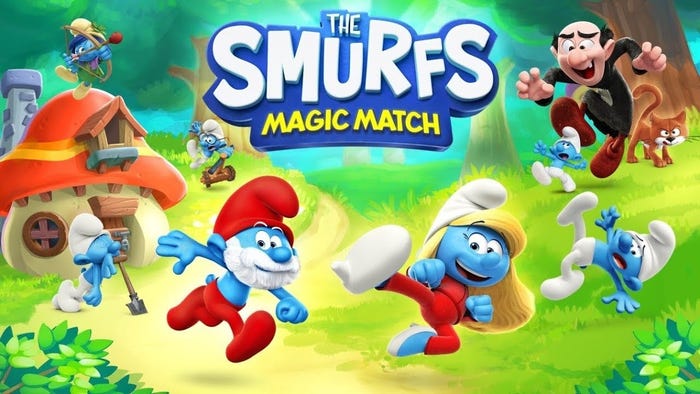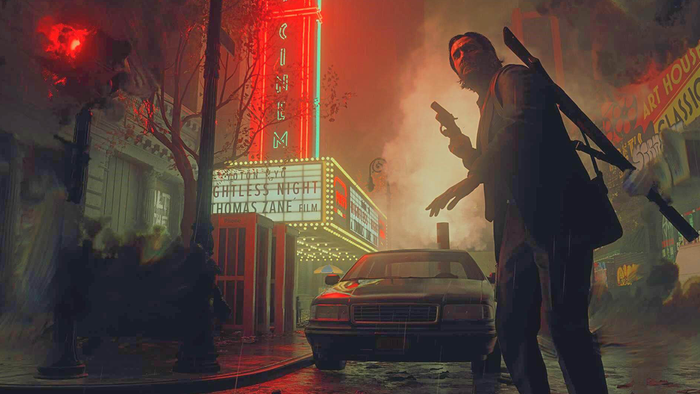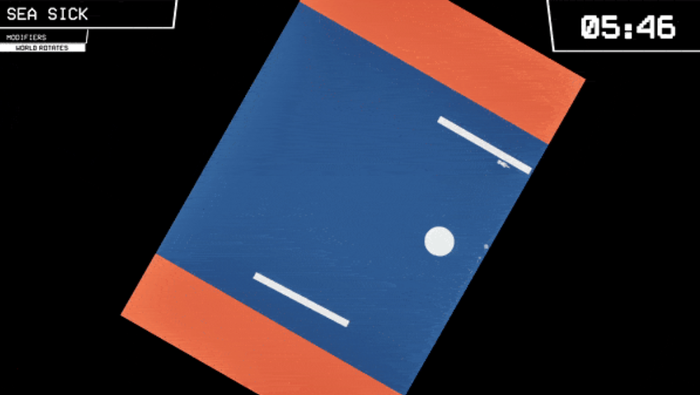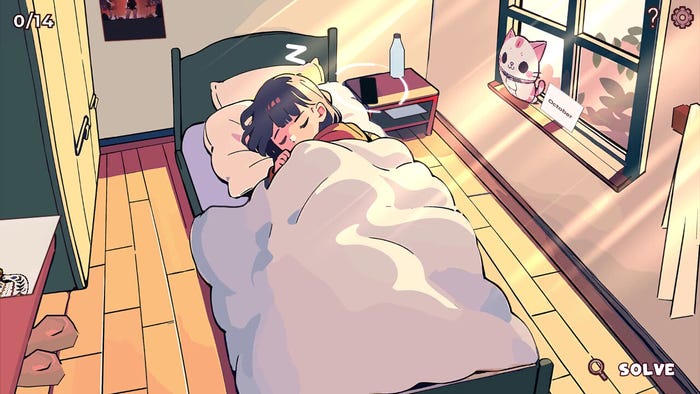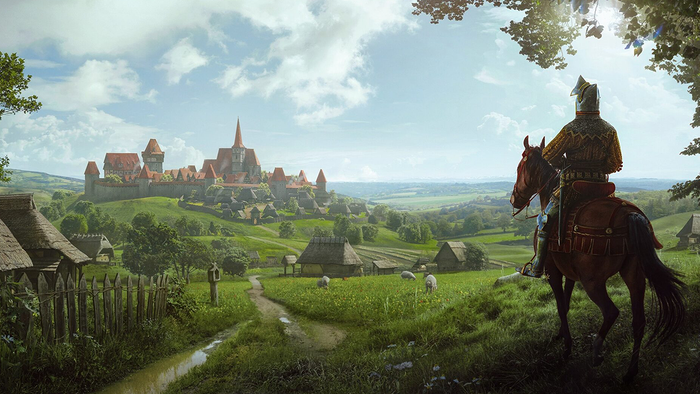
Featured Blog | This community-written post highlights the best of what the game industry has to offer. Read more like it on the Game Developer Blogs.
A game creator in an Artist Residency: my experience at Villa Kujoyama
This article is about the great experience I got the chance to live in 2019: becoming the first game creator to be selected at Villa Kujoyama, a French Artist Residency program. Let me tell you everything I did during 5 month in Kyoto.

Christophe Galati - Game Creator - Himitsu Project
January 5 - May 31 2019
Bonsoir and welcome to this article! I’m Christophe Galati, a French game creator. You may have heard of a game I created called "Save me Mr Tako!", which was released on Nintendo Switch and Steam in 2018. Today I’m here to talk to you about a great experience I got the chance to live in 2019: I became the first game creator to be selected at Villa Kujoyama, a French Artist Residency program in Kyoto.
Villa Kujoyama, picture by Kenryu GUAn Artist Residency program is a support for the mobility of artists that France sends in another country for a few months, give a place to live and pay them to work on their own projects, without expecting anything in return. I heard about those kinds of program thanks to a documentary about Villa Medicis, the oldest French artist residency, and I thought that it would be great to have this kind of programs for game creators. It could help for the recognition of games as an artform and bring the resources that indie game creators often lack. Villa Medicis does not welcome video game creators yet, but then I heard about Villa Kujoyama, which was way more suited for me as my games are very inspired by Japanese culture and because I already had a foot in Japan thanks to the various game events I attended there. I applied, thinking I’d be overlooked because games were not in the artistic fields list (like composer, painter, dancer, architect, movie director…), and I didn't meet the age requirement. But in the end, the jury was very welcoming about games, and I got selected!
Villa Kujoyama, picture by Kenryu GUI spent 5 months in Japan, between January and June 2019, in this kind of grey fortress on one of Kyoto’s mountains. In this inspiring environment I started to work on my new game, currently called “Himitsu Project”, which will also be a tribute to a Japanese game era. The central theme are secrets and how they turn into shadows. I was able to take time to research for the universe and starting to prototype, it’s still the beginning of the project but it’s currently leaning toward the Action RPG genre. I’m going to talk to you about how I spent those 5 months and how I work, in the following categories:
I) Research
II) Pre-Production and documentation
III) Prototype development
IV) Personal growth
V) Entering Kyoto Indie Scene
VI) Conclusion
I) Research
I arrived in Japan during the night on January 5, in the first batch of artists of the year. At Villa Kujoyama, each artists get between a 2 to 6 months stay. After acclimating, meeting the other artists (a dancer, two puppeteers, a typographer, and later a writer, an architect, an exhibition commissary, jewels and bamboo items designers...), I directly started to do preparatory research and to write new ideas, as almost a year passed since I submitted the new game ideas in my application to the french Institute in Paris, of which Villa Kujoyama is a residency program. I started to write in a diary what I was doing, I completed it everyday to keep a written record of this once in a lifetime experience, and also as devlog of the project progress.
One of my first research field was learning new softwares to become more efficient, as it gave me time to learn. I quickly setup my work environment with the new version of Unity (game engine that I used for Save me Mr Tako) and read tutorial of the new features, like the UI System and Tilemap tools. Then I started to learn how to use better Pixel Art tools, as I did all of Tako’s graphics in Microsoft Paint. I chose Aesprite, which I’m still learning today.
During all my stay, I took the time to play some classic games of the JRPG genre (the one I want to explore with Himitsu Project), as Mother 3, Terranigma, Final Fantasy IX... in order to analyze how they were conceived, what made them legendary and inspiring even today, learn the codes and trope to use them to create something new in my game. I also took advantage of the fact that I was in Japan to go to many retro game stores in Kyoto, Osaka and Tokyo, for contemplating the Japanese box arts (which are quite often different that the versions we got in the west), it was such a treat to find all the games that inspired me, and to introduce some of them to the other artists.
Pictures by Christophe Galati at Osaka’s Super Potato, March 3 2019One of my goals when designing a game is to use classic codes and aesthetic to create something new, more modern and inclusive. I got very attracted by the Drag culture in the past few years, and I want to explore that universe through one of the characters in the game. When I lived in Paris, I used to go see Drag performances, so while I was in Japan I also wanted to saw some local performers to enlarge my vision. So I went a few times to the Diamonds are Forever party at Club Métro in Kyoto, as well as a few other drag show in Osaka and Tokyo, where I met and talked with very talented performers. I want to keep in touch with them to write a character and depict a drag scene as accurate and true as possible.
Picture from Christophe Galati at Diamonds are forever, Club Metro, February 22 2019Finally, the life with the other artists, all the people I met in Japan also made me grow as a person, and are inspiring my creation. In the gaming scene, I don’t often have the chance to meet artists from completely different fields. Getting the opportunity to talk about various subjects with them and to be able to be 100% myself, far away from everything I know, was very refreshing. I was also able to meet again a long time internet friend in Osaka, MetalRenard, composer who was actually making the musics for my RPG Maker games back in high school. Every Monday, we did a movie night at the Villa Kujoyama, which made me discover many movies, and discuss about the intentions behind them with the others. The various Matsuri as Setsubun (spring festival), the nature around the Villa Kujoyama (I could observe foxes, monkeys, boars, dears, tanukis…), visiting many temples in Kyoto, Nara, my Takoyaki parties, karaoke… all those great memories of scenes I will unconsciously transcribe in my games, and that I couldn’t have experienced in such good conditions without the Villa Kujoyama.
Picture from Alessandro de Bellegarde at the Open Studios, March 16 2019
Takoyaki by Christophe GalatiII) Pre-Production and documentation
Picture from Villa KujoyamaWhen I entered the Villa Kujoyama, I already had the early ideas for the story and gameplay of the game, that I started to write in documents. My goal for January was to complete all those preparatory documents with a more clear vision of the project. I then continued to update them during all my stay, following the new ideas that arose during my research. Here are the different kind of documents I worked on:
Game Design Document
This first document, usually call GDD (Game Design Document) is said to be the “bible” of a game project. It describes and list every features, systems, patterns, metrics, how the game is played, what the designers wanted to express, so every people in the production team have the same vision. Even if I work alone, I think it’s a good exercise to create this kind of document to organize my ideas and have a clean line for the project to follow, even if it evolves during all the development. The basic component of a GDD are the 3C : Character, Camera, Controller : describing who the player is, what he can do, how he sees it, and how to play (for example the inputs). I first did a one page version, before making a more complete document. Then I translated it in English so it’s more convenient to send it to publishers/people I want to work with, so they can understand where I want to go with the game, what is planned, even if the current prototype can’t show it yet.
Universe, Story and Chara-Design documents
When I write a story, I always start by setting up a mythology, how the world was created, all its history from its creation to the beginning of the game. I call it Universe document, it also list all the places, era, conflicts and customs to understand the world of the game.
The Story Document starts at the beginning of the game, and lists, as a movie script would do, all the scenes where the story of the game will be told. I usually divide it in several acts, with the key points and plot-twist highlighted. For Save me Mr Tako, I left some holes in the script to leave space for the new ideas that arise during the development. I also fill it with screenshots from the game when the scenes are implemented, turning it into a kind of illustrated book of the story of the game.
I also wrote a Character-Design Document, where I list all the characters, the main cast, villains, and important NPC. I write their background, habits, their goals, the message behind them, and graphic references. I gave this document to Valentin Seiche, the illustrator who made the key Art for my previous game, and he started to design the main characters.
Early Character Design by Valentin Seiche for Himitsu ProjectGraphic References Document
This document list all the graphic reference I have, the games that inspired it, describes the limitations, colors and mood wanted. It’s also where I put mockups, so if one day I start working with graphic artists, they will be able to directly understand the visual vision of the project, and use this same document to communicate their vision.
Technical Document
To finish, the TDD (technical design document) is here to list all the game systems, how they are technically implemented. You can find the various “classes”, the game architecture, all the softwares and plugins used in the project, so each developer can understand the code of each others. Even when working solo, it’s useful to remember some decisions, as it’s easy to forget why you implemented something the way it is with time, and to not understand your own code anymore. I started one while working on the prototype, even if the code is not final and might be dropped.
Picture from Villa KujoyamaIII) Prototype development
After setting up my work environment and the basics of most document in January, right in February I was able to start prototyping Himitsu Project. I started to list the various tasks on Trello and in the technical document, and made a planning of allocated tasks for each months.
My first mission was to implement the 3C, having the control of the character (move, jump, run…). I don’t really like to prototype with blocs, so I started with a sprite of a character I drew for a previous prototype (Memory from the Grave), with a background from Illusion of Gaia, which is one of my main references for this project. Right from the start I fixed the screen resolution to be true to the Game Boy Advance, this way I’ll avoid to fall into the same trap that bothered me during the whole development of Save me Mr Tako (like the Pixel Perfect setting in Unity).
After half a month, I started to make my own “sprites”, graphical elements for both the characters and background, to eliminate all the “placeholder” (provisory assets brought from other games). It’s at that time I started to implement the map and collision system. For the camera and different screens, I took and refined what I used in my previous game. I also found a free plugin, SuperTiled2Unity, to optimize the collisions and to get a nice workflow to create content quickly, one other aspect of development which took many times for Tako.
I optimized all those systems and the code architecture, added a bit of UI and menus, the swim feature... until the Open Studios, big milestone of my residency stay where I had visitors who were able to test the prototype, next to Save me Mr Tako. Villa Kujoyama does Open Days 3 times each year, so visitors from the artistic scene, politicians, press and the artist's own guests can come to the residency and see the work of each artists. Near the games, I printed slides explaining how I work, a few spritesheets, as well as an exhibition of retro games, explaining the different era as a player in my life, and how they inspired me. It was nice to see visitors who at first doubted why a game creator was here, but then realized that games have been part of their life too, that it is as inspiring as any other art and that it was logical that those kind of place are starting to open up to those creators .
I lost a bit of time on the map system, the z-order and collisions, I had to wait for the developer of the plugin, who upgraded it so it works well for my needs. I used this time to complete my documentation and refined the already implemented systems according to the feedback I received during the tests, as the feeling of the jump, how you fall in holes, the character respawn...
After a trip in Tokyo in April, I finally got the gameplay vision that I missed before, the idea behind the upcoming battle system, how the player will fight the shadows in the game. Unfortunately I barely had the time to implement it while I was there. I spend the last months refining those systems, implementing the dialog and cutscene systems, all those things we can’t see but which, if implemented well, will save me precious time in the future. I couldn’t go as far as I wanted, but I have a cool base I can build on.
IV) Personal Growth
The goal of Villa Kujoyama is to become a privileged moment in the life of an artist, like a spiritual journey to reinvent themself. I have the feeling that it happen in the perfect time for me, even if I was only 24. I was just out of 4 years of intense production of Save me Mr Tako, who kind of burned me out as I had to deal with it and a daily job, and I didn’t really take care of myself during that time.
Thus, one of my side goals was to get in a better shape. Without the financial pressure, I was able to take time to live correctly, set up a routine with a fitness session every morning. Following the same video everyday, the fact that I live on a mountain, cooking Japanese food, all those elements formed a healthier lifestyle, which allowed me to lose a lot of weight during my residency.
Pictures from Villa Kujoyama, January/May 2019I was able to take Japanese lessons again, I started when I was in high school but had to stop when I left to study game design & programming. Since January I had 2 lessons a week at the Villa Kujoyama, and an other lessons in a school when my initial teacher was away. In addition to those courses, I wrote one page of Kanji each days. I felt a great progression in my Japanese level, which will hopefully be useful moving forward in my career, and allow me to appreciate Japanese culture even more.
All this time in this monastery on the mountain allowed me to take a step back and think about my life, focus on what I want to create and achieve, far from my life and its issues. Learning about all the other artists experiences, meeting a lot of new people, being inspired, live a romance… I learned a lot, became more eloquent and confident in myself. As if I had a speeded up complete life in a bubble during 5 months, with different eras, different seasons, I feel like I grew up. In a way, I needed that, and will now be able to give myself 100% in my projects, try the new paths I thought about to stay indie and continue to create to share my messages.
V) Entering Kyoto Indie Scene
Last and not least, while doing this residency I wanted to meet with the Japanese indie scene, that I started to experienced when I went to game events in Japan to showcase Save me Mr Tako. I wanted to become part of it, talk about Villa Kujoyama, try to inspired the other with my story. Here are a few events where I was able to show my work.
Osaka Indie Meetup IchiPixel :
https://www.youtube.com/watch?v=pUt9bzMQzN8
Picture from IchiPixel, January 25 2019Kyoto Indie Meetup
Picture from Game Attack Info, February 16 2019Open Studios Villa Kujoyama (March 16)
I gave a talk in a class at Tokyo Polytechnic University (April 19), to inspire the students.
I also gave class and made food for the students at ic cube in Kyoto Seika University (April 24/ May 22)
Out of the meetup, I was able to meet many people from the game industry, for example during the Taco Tuesday, weekly event where employees from the 3 main expat companies of Kyoto go eat mexican food (Q-Games, Vitei and 17bits). I was able to get an appointment at Nintendo on February 20, where I met with the team in charge of indie games, talk to them about Tako and my new game, to set up an exchange and regular follow-up with them. During my week in Tokyo, I also met with local indies, and visit Unity’s office.
The culmination of all its events and the people I met there, was the organization of a Game Jam at the Villa Kujoyama, which I co-organized with the help of Kyoto Indie Meetup’s staff (Marie-Aurore Morfoisse, Thomas Olsson, Shawn Wylie) and Zack Wood (Monster Garden’s developer). Our jam was sponsored by Unity Japan, who send us beers, merch and asset store’s coupon for the attendees. A game jam is an event where you create a game during a limited time, here during 8h. We were able to welcome about thirty people at the residency, coming from the meetup, the different game companies of the Kansai area but also from Kyoto artistic scene (thanks to Villa Kujoyama’s network), ¾ of the attendees had never done a game jam before. This event allowed those scenes to meet up, form groups and create together, celebrate video game in this magical place. I’m proud to have been able to make this happen, and to show to the artistic scene the creativity of games as an artform. I hope it’s only the first edition of many upcoming Kujoyama Game Jam !
Picture from Villa Kujoyama, May 18 2019Pictures of the Game Jam :
Games created during the event :
https://itch.io/jam/kujoyama-jam-x-kyoto-indie-meet-up
To finish this residency on a high note, I spent my last two days at BitSummit, indie game festival of Kyoto where I showcased Tako in 2017. I could see the evolution, how big indie games are becoming in Japan, and meet again with game creators from all over the world, discuss with them about what I want to do. This made me desire one thing, work even harder on Himitsu Project to come show it at BitSummit next year!
Pictures from BitSummit twitter accountVI) Conclusion
To conclude, I would say that I’m honored to have been able to enjoy those 5 months of residency at Villa Kujoyama. I was able to get in a better shape, grow up and evolve on the land of my inspirations. Take the time to think and lay the foundation of my new game. Experience the life in Kyoto surrounded by people from very different background, who taught me a lot, opened my eyes on the parallel we can draw between our medias, and provided me confidence on the messages I want to defend in my creation. I am happy that I was able to show the creativity of game through my work and the game jam. As the first game creator they ever had, I tried my best to represent the various aspects of game creation to the visitors of the Villa, I want to continue to try to organize things with the French Institute and press to talk about this experience, to show other game creators that there is a room for them in the artist residencies and that we have to continue to help games to be recognized as an artform. All this gives me one wish, return to Japan as soon as possible to continue my adventures and my creation! Hope this article inspired you, I can't wait to tell you more about my upcomming game.
Christophe Galati
Links:
Read more about:
Featured BlogsAbout the Author(s)
You May Also Like
